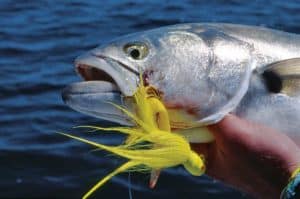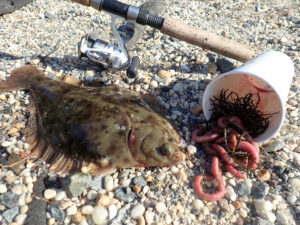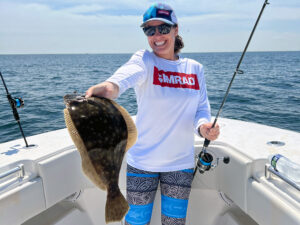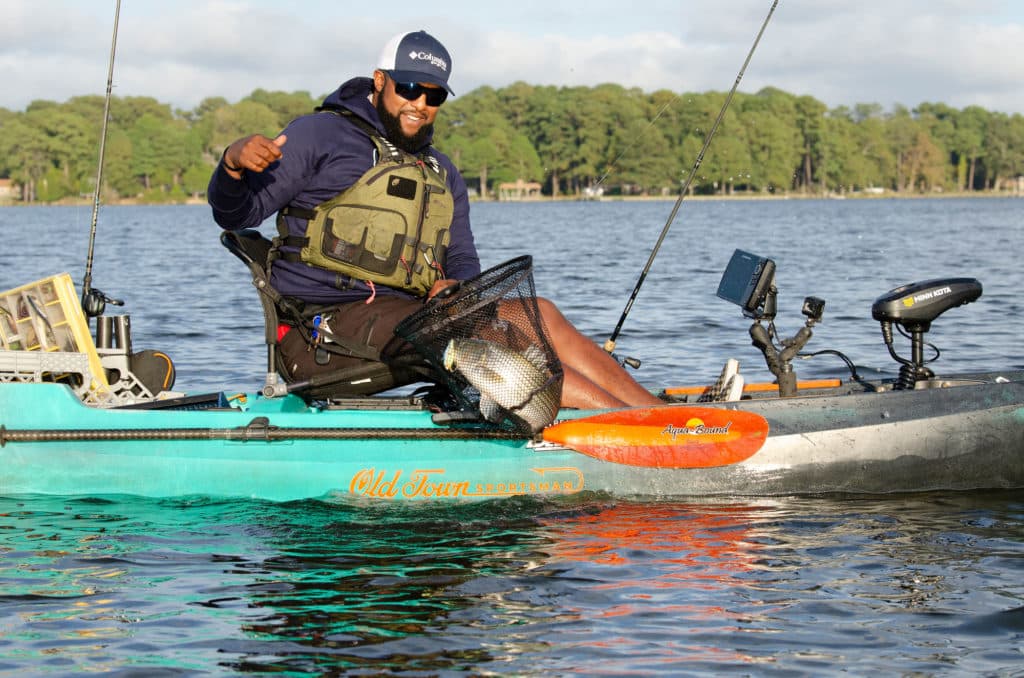
Even though winter fronts have chilled the nearshore waters, anglers from the mid-Atlantic to the Gulf Coast still have a shot at great action. Fishing the offseason can be challenging: The fish scatter and the bait selection changes. You need a light touch with the right lure to convince a cold-blooded fish to heat up. I caught up with three top inshore guides for some insider tips to keep us warm through the winter.
Striped Bass Winter Fishing Tips
As far north as New England, anglers fishing tidal creeks and mud flats find great inshore action on striped bass late into the season. On Virginia’s eastern shore, Capt. Kevin Josenhans patrols the marshes and bays around Tangier Sound. When the water temperature drops into the 50s, he turns to creek fishing, beating the banks with jigs and flies in search of cold-water rockfish.
To locate winter striped bass, find the warmest, clearest water, Josenhans says. Even on a windy day, he plays the angles to find fishy conditions. Work the last half of the outgoing tide: “The water moves into the marsh and clears up,” he explains. Water temperatures also warm as the current rushes out of the shallows. When the water level drops, Josenhans says bass get stranded in deep pockets.
Striped bass change their menu when they move into the creeks. “The fish are feeding on small crabs and killie minnows,” he says. For light tackle, he likes a 3-inch paddletail on a ¼-ounce jighead. “The light jighead settles slowly, attracting the fish’s attention.” Use a hop-and-pause retrieve. “They always hit it on the drop,” he says.
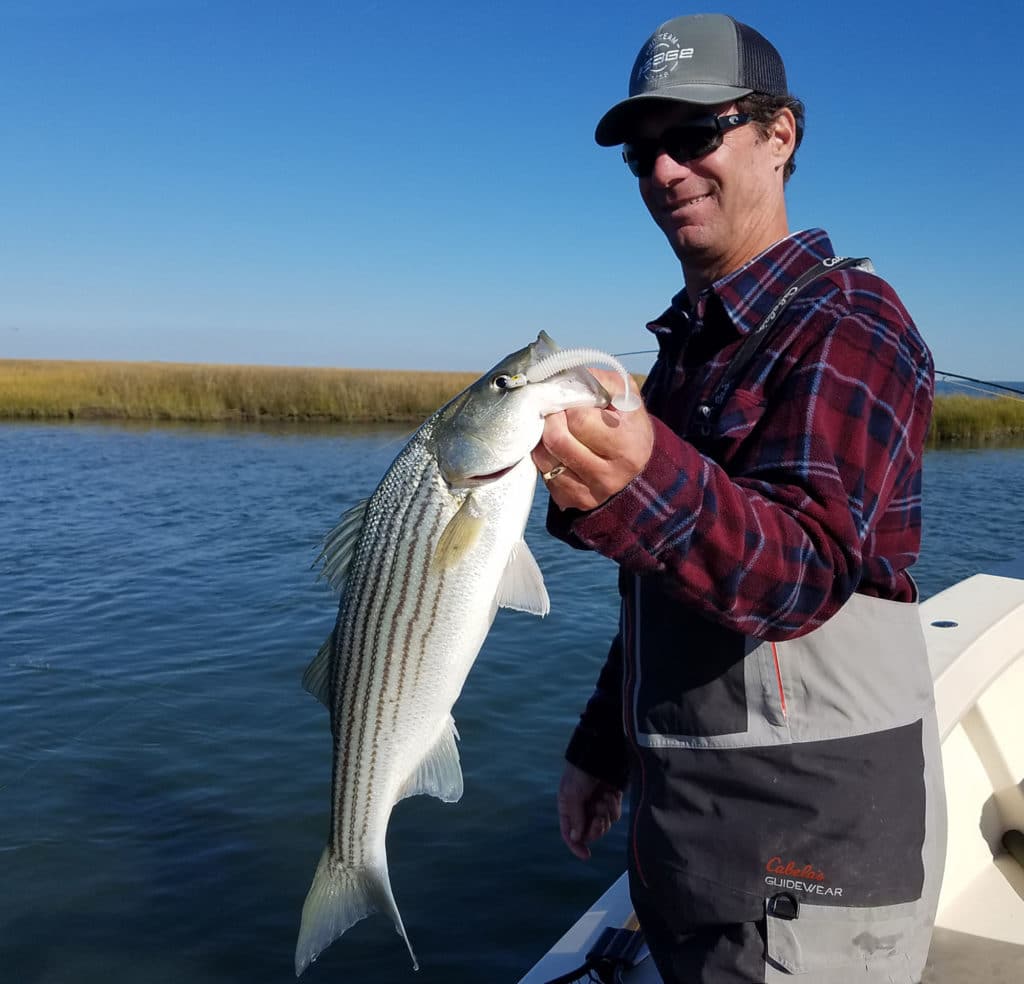
Later in the season, he might change his preference to fishing the incoming tide, when warmer, clearer water runs in from the Chesapeake. He has caught striped bass on warm, sunny days with an incoming tide pushing the water temperature into the upper 40s. “Once the water drops below 44, the fish won’t bite,” he says.
When he’s fly fishing, Josenhans usually ties on a chartreuse-over-white Clouser minnow. “The other day, I switched to olive over white and started catching. Maybe the fish thought it looked like a crab,” he says.
By finding the warm, clear water and matching the size and color of local bait, Josenhans catches striped bass deep into winter.
Speckled Trout Winter Fishing Tips
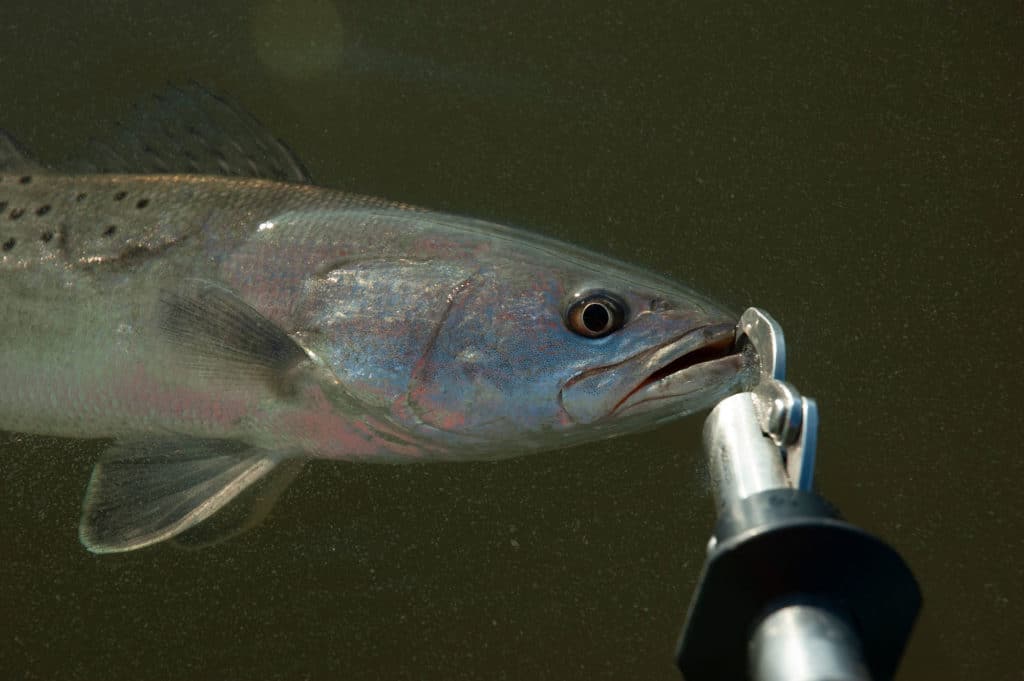
Most of the winter, speckled trout range from northeast North Carolina through the Gulf Coast. Although the action slows and the fishing becomes more difficult, the cold months can produce the biggest speckled trout of the year.
Capt. Jot Owens specializes in speckled trout fishing out of Wrightsville Beach, North Carolina. From early fall and into late November, he finds trout in creeks and flats of the surrounding estuary. But, he says, “as the water temperature drops into the 50s, the fish move to the deeper holes around the inlet.” This observation holds throughout the trout’s range: Cold water chases speckled trout into deeper water. “In the winter we’re seeing the biggest fish, with 4-pounders almost daily,” Owens adds.
Owens stresses the importance of water temperature when finding big winter trout. The water only has to heat up for a few hours, he says, which—around the inlet—happens on the incoming tide. In another scenario, Owens says a warm day can make the outgoing tide a better bet. “If we have an Indian summer, the water warms in the shallows before running back out to the ocean.” With cooler water temperatures, he focuses on channels leading to the inlet and the inlet itself. “I fish shallower areas during high tide and deeper areas on the low tide,” he says.
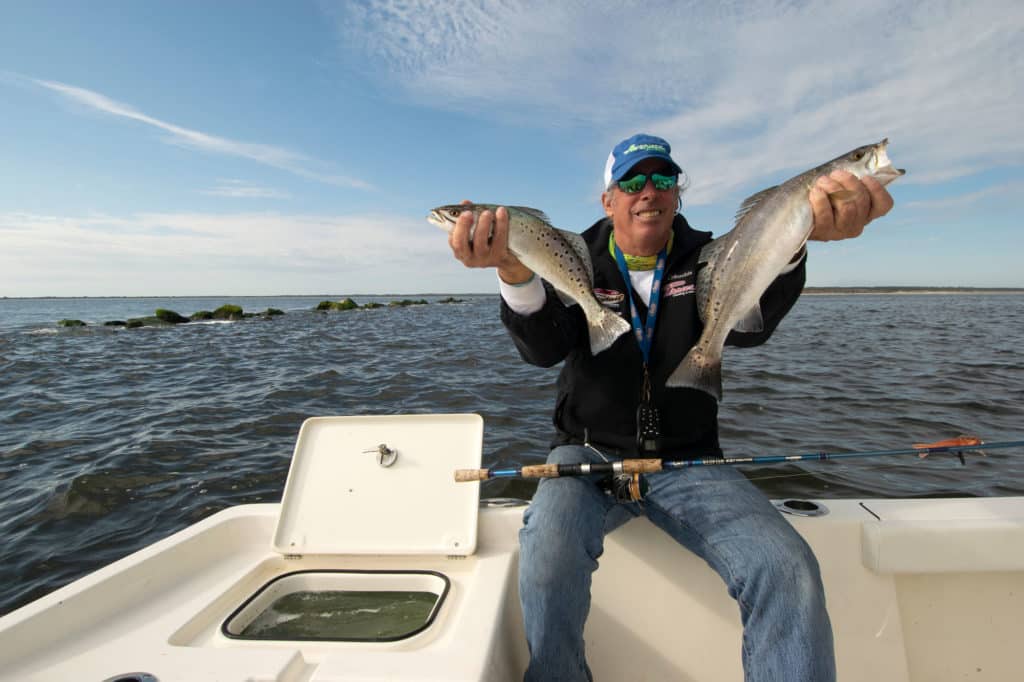
Owens prefers a suspending twitchbait, such as the MirrOlure 51MR and 52MR. The slow, erratic retrieve turns on the fish. When the water temp drops below 60 degrees and he targets deeper water, he bumps up the weight of the twitchbait. In clear, cold water, spotted seatrout can be very finicky, so Owens uses 15-pound fluorocarbon leader. “If the fish are really picky, I’ll add up to 3 feet of flouro to my braided main line,” he says.
He presents the twitchbait very carefully: “I give the rod tip a twitch, twitch, pause,” he says. He suggests leaving slack in the line after the last twitch, and don’t turn the reel handle until just before the next series of twitches. This allows the suspended bait to fall slowly, at a perfect angle.
When the bite slows and he’s searching for fish, Owens works a Berkley Powerbait on a 1/16 or ⅛-ounce jighead. He says an injured glass minnow slowly sinking through the water proves too much for the fish to deny. Lures and locations for speckled trout fluctuate with the water temperature. “I’ve had days when the water warmed up two degrees and the bite was on,” he recalls. “Winter can be the best time for a trophy.”
Winter Redfish Recommendations
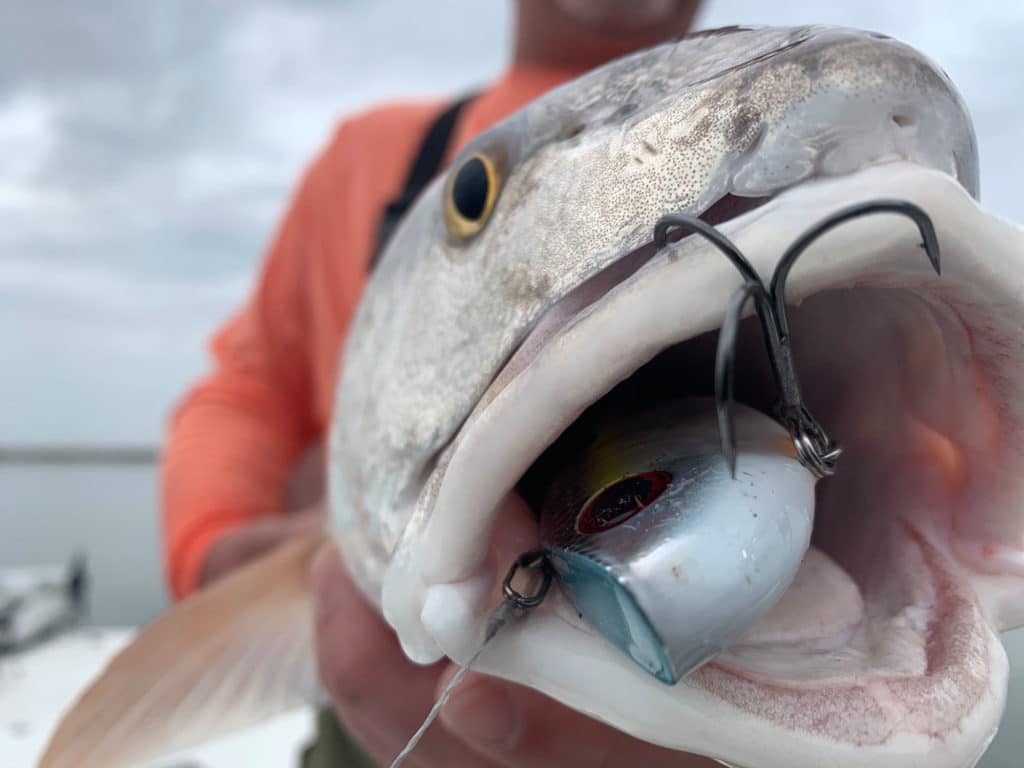
From North Carolina to South Texas, anglers chase redfish throughout the offseason. And like other species, redfish change behavior when the water temperature drops. The days of sightcasting to tailing reds might be over, but that doesn’t mean redfish action ends.
Fishing out of Venice, Louisiana, Capt. Mike Frenette says winter redfishing ranks as one of his favorite pursuits. “A lot of people think we don’t catch reds in the winter,” he says, “but we just look to deeper water and slow down the retrieve.” As a tournament angler, Frenette has fished for reds all over the Gulf and Southeast coasts. In his travels, he has noticed many similarities in offseason redfishing.
Again, water temperature plays an important role. When the thermometer hits 57 to 62 degrees, he searches for reds in deeper cuts in the marsh near the main river channel. “I look for sand flats near deep water, submerged oyster beds, rocks or jetties,” he says. To fish the structure, Frenette seeks a warm-water eddy. “I can move 100 yards and find water a few degrees warmer,” he says. Even a slight change in temperature attracts the fish.
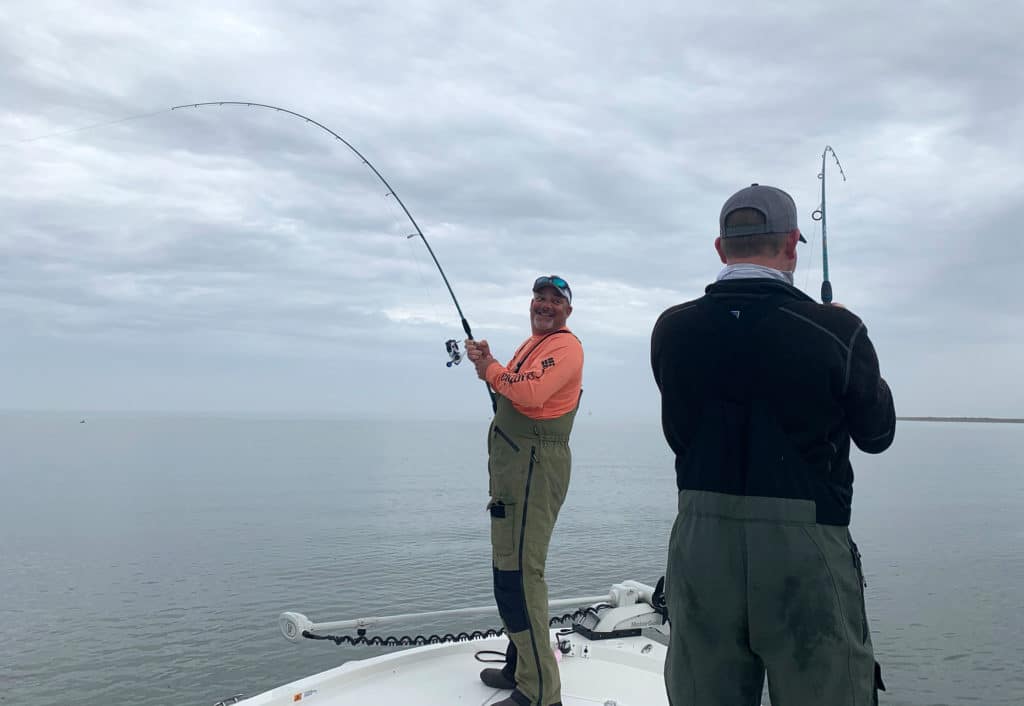
He also chooses where to fish based on the wind direction, moving to the leeward side of the main river channel. Not only does that allow him to escape the breeze, but he can find better water conditions. Frenette uses water depth to guide his lure selection. When fishing in 3 to 4 feet of water, he chooses a shallow-running crankbait, such as a Strike King Red Eye Shad. He can fish that over the bottom without snagging on oysters and rocks.
In deeper depths from 6 to 12 feet, he opts for a jighead and plastic tail or a deeper crankbait. “I want a bait that goes straight to the bottom,” he explains. Maintaining contact with the bottom is key to attracting reds. Frenette says mud boiling up from the lure brings in the fish. “Winter fish aren’t going to chase down everything,” he says, recommending a slow retrieve to give the fish plenty of motivation to attack.
If all else fails, Frenette relies on a popping cork to draw redfish to the bait. “I know the cork will find redfish,” he says. In 3 to 6 feet of water, especially if the water is stained, the splashing and banging cork attracts even the most finicky reds. All three captains agree that winter fishing can be challenging, but the rewards can be surprising. “I’ve had some great days, totally unexpected,” Josenhans says. And that’s enough promise to keep any angler warm.

